Christmas decorations and traditions have a way of carrying deep spiritual meanings that go way past their festive look. Each symbol, from the Christmas tree to the Star of Bethlehem, points to bigger truths about spiritual growth, divine guidance, and honestly, the whole sacred journey of faith.
When you put a star on your tree or hang mistletoe up, you’re actually joining in on traditions that go way back. These cherished Christmas symbols have been handed down for generations, each holding stories about hope, renewal, and the kind of light that beats the dark.
If you start looking at the spiritual meanings behind these familiar Christmas things, your whole holiday experience can shift. Decorations like candles, holly, and nativity sets aren’t just pretty—they’re reminders of truths that can make your celebration richer and more meaningful.
The Spiritual Essence of Christmas Symbols
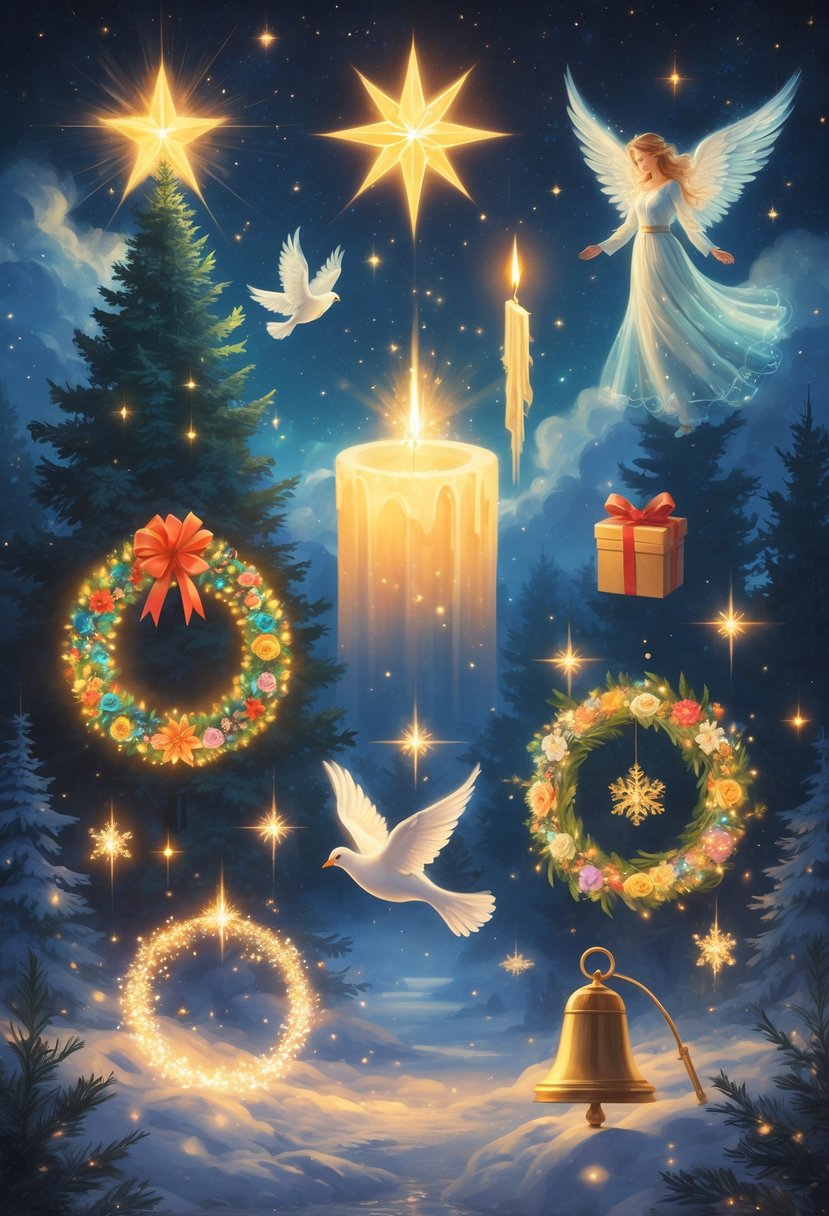
Christmas symbols reach right into the heart of the nativity story and the values of hope, love, and faith. These emblems turn regular festivities into traditions that honor something sacred.
Birth of Jesus and the Christmas Story
The birth of Jesus Christ sits at the center of every Christmas symbol’s spiritual meaning. Every decoration and tradition somehow circles back to that story in Bethlehem.
The star? That’s the Star of Bethlehem that guided the wise men to Jesus. When you put a star on your tree, you’re nodding to the idea of divine guidance.
Angels stand for the messengers who announced Jesus’s birth to the shepherds. Angel ornaments remind you of that heavenly announcement and the joy that filled the night.
Gifts with bows? Those connect to the wise men’s offerings of gold, frankincense, and myrrh. These presents echo the ultimate gift—God giving humanity His son.
The nativity scene brings the whole story together in miniature. Each little figure has its own part in the sacred narrative.
Symbolism of Hope, Love, and Faith
Christmas symbols pretty much embody the big three: hope, love, and faith. Red and green, especially, have deep roots in all this.
Red stands for Christ’s sacrificial love. Red ribbons, berries, and decorations? They’re all about God’s love and Jesus’s sacrifice.
Green means eternal hope and everlasting life. Evergreens, wreaths, and holly stay bright even in winter, symbolizing the immortality Christ offers.
Candles chase away the darkness, just like Jesus brings light to the world. The tradition of candles on Christmas trees is really about the Holy Spirit lighting your way.
Wreaths, with their endless circles, stand for God’s love that never ends. The evergreen branches? They’re a promise that hope sticks around.
Bells ring out to celebrate Christ’s birth. Their sound is a call to rejoice in the salvation Jesus brings.
Tradition and Celebration in Spiritual Context
When you know the meanings behind traditions, your Christmas celebration takes on a spiritual depth. These customs tie you to centuries of Christian worship.
Decorating the tree isn’t just for looks—it can become an act of worship. The tree itself stands for the Tree of Life and Christ’s presence in your home.
Gift-giving mirrors God’s generosity. Every present exchanged is a small way of sharing God’s love with someone else.
Lighting candles at Christmas invites moments of reflection on Christ as the light of the world. It’s a simple act, but it connects you to deeper meaning.
Family gatherings echo the holy family—Mary, Joseph, and Jesus. Sharing meals and stories brings to mind the community around Christ’s birth.
Singing carols spreads the joy of the nativity, just like the angels did that first night.
Christmas Tree: Symbol of Spiritual Growth and Eternal Life
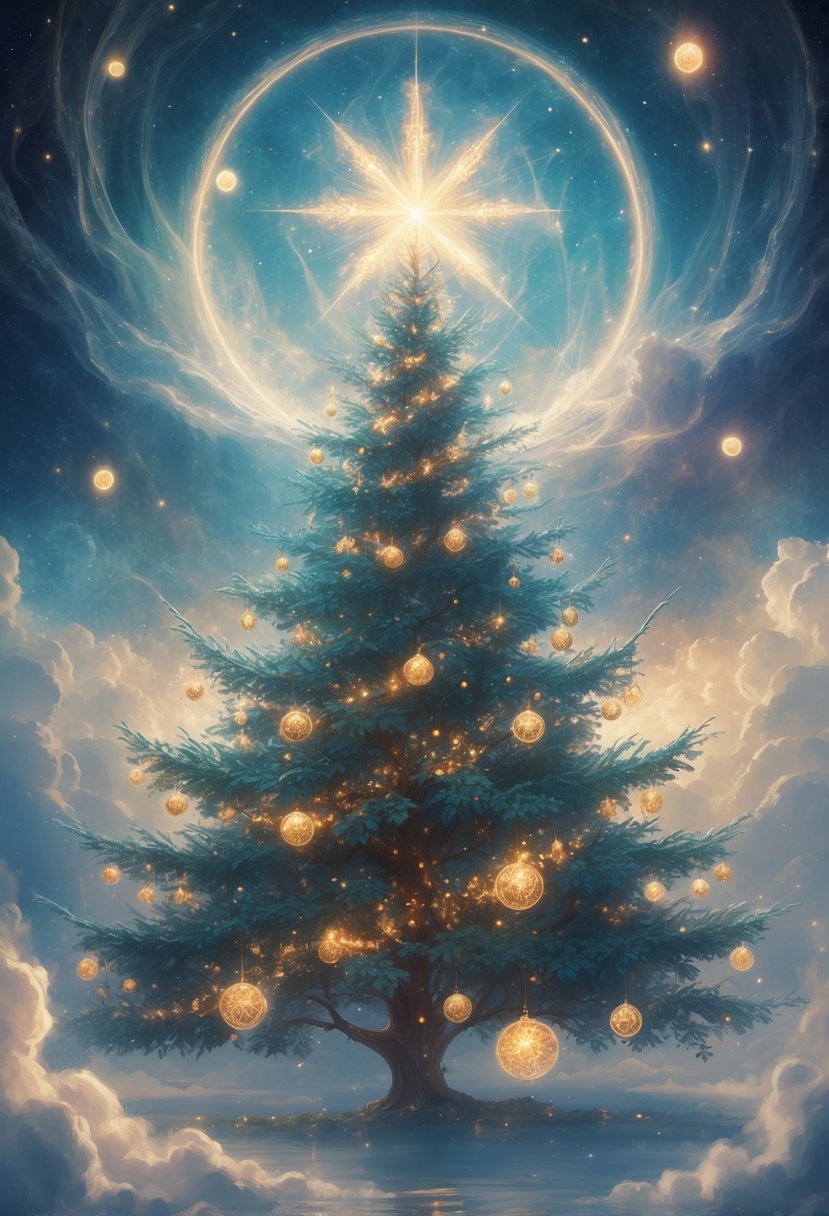
The Christmas tree stands out as one of Christianity’s most powerful symbols. It embodies eternal life and resilience through its evergreen nature.
Your family traditions and decorations tied to this symbol hold deeper meanings about spiritual growth and divine connection.
Origins and Religious Significance
The Christmas tree tradition traces back to 16th-century Germany. Martin Luther is said to have added candles to an evergreen, blending old pagan customs with new Christian symbolism.
The tree’s triangular shape? Many see it as a nod to the Holy Trinity – Father, Son, and Holy Spirit.
Early Christians looked at the evergreen as a sign of Christ’s eternal nature. Bringing one home is a way to honor everlasting life through faith.
The tree’s branches reach upward, almost like prayers stretching toward heaven. This vertical pull represents your own journey of spiritual growth and connection to the divine.
Evergreen Qualities and Renewal
Evergreens stay green during the coldest, darkest months. That resilience stands for the promise of eternal life and spiritual renewal—a hope that doesn’t quit, even when things get tough.
The evergreen’s ability to thrive in harsh conditions mirrors your own spiritual path. When other plants fade, the evergreen keeps going, just like faith can stay strong during hard times.
Key Evergreen Symbolisms:
- Immortality – Life continuing after death
- Hope – The promise that spring will return
- Resilience – Strength through challenges
- Renewal – Spiritual rebirth, over and over
When you look at your Christmas tree’s greenery, it’s a gentle nudge to trust in nature’s wisdom and the ongoing cycle of renewal. Maybe it’s a reminder to keep hope alive, no matter what.
Decorations and Their Deeper Meanings
Christmas tree lights symbolize Christ as the light of the world. Each little bulb is a spark of hope in the darkest season.
Ornaments aren’t just for show; they carry meaning. Each one might stand for a blessing, a memory, or a spiritual quality. When you pass down ornaments, you’re connecting generations and faith.
The tree topper—star or angel—always means something. The star stands for the Star of Bethlehem, guiding the wise men. An angel brings to mind those messengers announcing Christ’s birth.
Common Decoration Meanings:
| Decoration | Spiritual Significance |
|---|---|
| Lights | Divine illumination, hope |
| Star | Divine guidance, Christ’s birth |
| Angel | Heavenly messengers, protection |
| Garland | Unity, eternal love |
| Ornaments | Life’s blessings, memories |
Decorating the tree as a family builds bonds and creates traditions that deepen spiritual connection. It’s a celebration, but it’s also a kind of gratitude.
The Star of Bethlehem: Guiding Light and Divine Guidance

The Christmas star stands for divine guidance and hope in Christian theology. It’s both a historical marker and a symbol of spiritual awakening.
This star guided the wise men to Bethlehem and still inspires Christmas traditions everywhere.
Star as a Symbol of Hope and Spiritual Awakening
The Star of Bethlehem acts as a beacon of hope and salvation for all mankind. It lights up the path through darkness and doubt.
When life gets rough, this star reminds you that divine light can break through any shadow.
Spiritual awakening often starts with recognizing a sign that calls you to something deeper. The Christmas star is that moment—a kind of wake-up call to the presence of something greater.
Its appearance marked a turning point in history. The star announced Jesus as the light of the world, offering hope to anyone looking for spiritual direction.
People today still look to the star as encouragement to trust in divine timing. Its bright light can help guide you through tough times and bring you clarity, just like it once guided ancient seekers.
The star’s meaning even goes beyond Christianity:
- Universal hope when life feels bleak
- Divine intervention in our stories
- Spiritual awakening and new understanding
- Faith that there’s guidance, even if you can’t see it
Connection to the Wise Men and Nativity
The three wise men—or magi—followed the Star of Bethlehem for miles to find Jesus. Their journey shows how divine guidance can direct your spiritual path if you’re open to the signs.
These travelers from the East recognized the star’s meaning through old prophecies. They brought gold, frankincense, and myrrh, starting the tradition of giving gifts at Christmas.
The nativity scene usually puts the Christmas star right above the stable. That spot highlights how divine guidance brought both shepherds and wise men to Jesus.
The magi’s dedication teaches us something about seeking. They traveled for months, trusting their faith in the star’s message.
When they finally found Jesus, their worship was a natural response to divine revelation. The birth of Jesus under the star’s light stands as a fulfilled promise—one marked by miraculous signs.
The Christmas Star in Modern Traditions
Contemporary Christmas celebrations weave the star into all kinds of meaningful traditions. You’ll spot Christmas stars on tree tops, shining as a symbol of the guiding light that led seekers to Jesus in Bethlehem.
Many families scatter star-shaped decorations around their homes during the holidays. These little reminders point to divine guidance and hope as the season unfolds.
Church services love to feature star imagery in Christmas programs and decorations. Nativity plays act out the wise men following the star to discover the Christ child.
Modern spiritual practices keep drawing from the Christmas star’s symbolism:
| Tradition | Meaning | Practice |
|---|---|---|
| Tree toppers | Divine guidance | Star placed highest on tree |
| Prayer focus | Seeking direction | Meditation on star imagery |
| Gift giving | Following magi example | Generous sharing with others |
Contemporary practices like meditation, rituals, and mindful moments can help you bring the Star of Bethlehem’s essence into daily life. Try using star imagery during prayer or reflection to connect with themes of divine guidance.
Nativity Scene: Humility, Simplicity, and the Holy Family
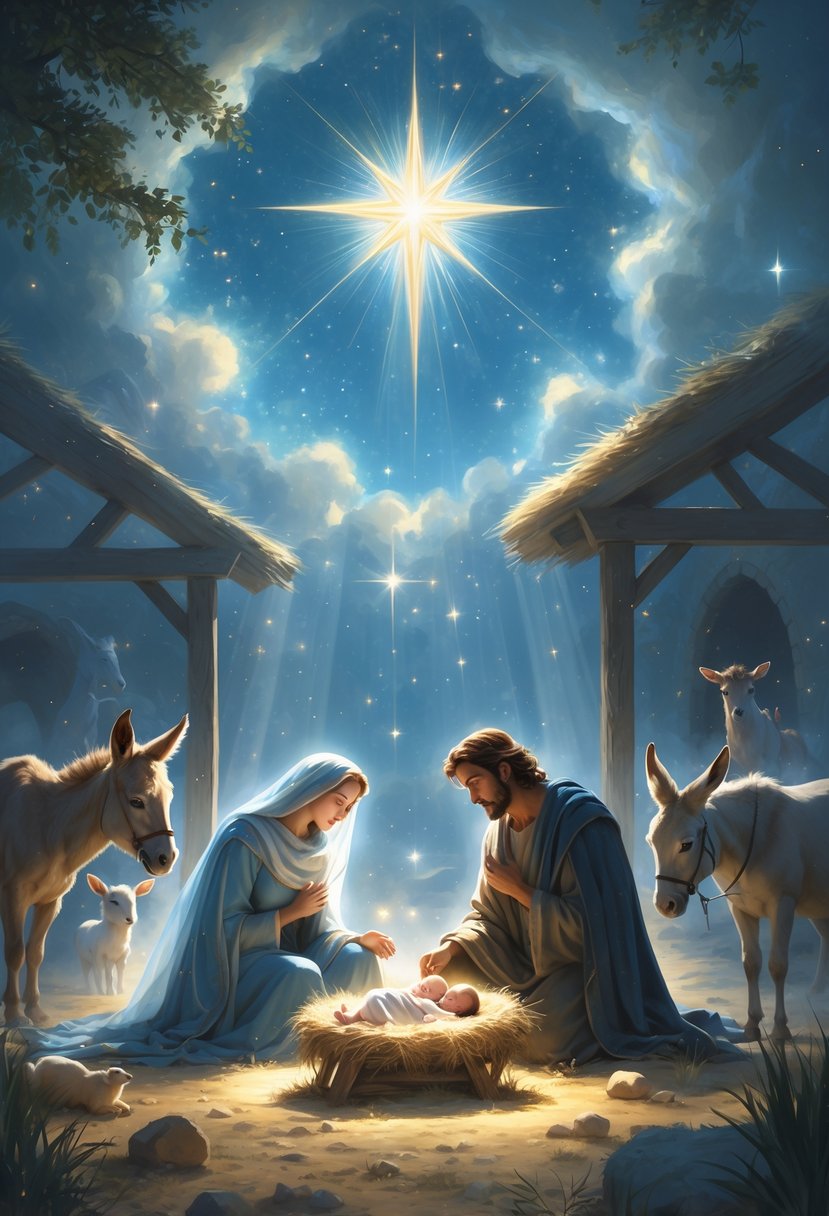
The nativity scene captures Christ’s humble birth in Bethlehem. It teaches powerful lessons about simplicity, divine love through the Holy Family, and the spiritual meaning behind the wise men’s gifts.
This cherished Christmas tradition nudges you to notice the extraordinary in the ordinary. Sometimes, the most profound moments happen in the least likely places.
Spiritual Lessons from the Manger
The manger setting flips expectations about power and importance. The greatest blessing ever bestowed is found in a lowly manger behind an inn, which still kind of boggles the mind.
God often chooses unexpected circumstances to work. The simple feeding trough where Jesus lay shows that spiritual transformation doesn’t need grand settings or material wealth.
Key spiritual lessons from the manger include:
- Divine blessings often show up in unexpected forms
- Humility, not status, is where true power lives
- God’s presence can turn any ordinary place into a sacred space
- Simplicity makes it easier to receive divine grace
The nativity scene’s rustic feel highlights that Christ’s message reaches people from all walks of life. Spiritual wealth really does outweigh material possessions.
Your spiritual journey starts humbly too—like the stable in Bethlehem. When you open your heart with simplicity, it becomes a sacred space.
Role of Mary, Joseph, and Baby Jesus
Mary shows what it looks like to surrender to God’s will, even when the path ahead is unclear. Her fiat—that “let it be”—is pure trust.
Joseph’s quiet actions speak volumes about strength. He protects and provides, teaching that real leadership means serving those you love.
The Holy Family’s individual contributions:
| Family Member | Primary Virtue | Lesson for You |
|---|---|---|
| Mary | Surrender | Trust God’s timing and plan |
| Joseph | Faithfulness | Protect and provide for others |
| Baby Jesus | Vulnerability | Embrace dependence on God |
Baby Jesus brings divine vulnerability right into the center. God chose to experience weakness and dependence—there’s a lesson there about finding strength in needing grace.
The Holy Family’s unity is honestly moving. Their care for each other shows how love weaves sacred bonds, and reminds you to nurture relationships built on faith and sacrifice.
Only his mother in her maiden bliss could worship the beloved with a kiss. Mary’s unique closeness to Christ is something you can echo through prayer and devotion.
The Visit of the Three Wise Men
The wise men’s journey is all about seeking spiritual truth. They follow the star with grit, showing that finding God takes dedication and a bit of courage, especially when the road is unclear.
Their gifts overflow with symbolism. Gold shows Christ’s kingship, frankincense his divinity, and myrrh points to sacrifice.
The gifts of the magi and their meanings:
- Gold: Christ’s royal authority over creation
- Frankincense: His divine nature as God incarnate
- Myrrh: His future suffering and death for humanity
The wise men, for all their learning, kneel in humility. Their worship proves that wisdom and reverence go hand in hand.
After meeting Christ, they return home by a different route. Encounters with divine love change you—there’s just no going back to how things were.
The wise men’s long journey and the shepherds’ short walk both lead to Christ. God calls people from every background to witness love in action.
Gifts and Gift-Giving: Spirit of Generosity and Goodwill
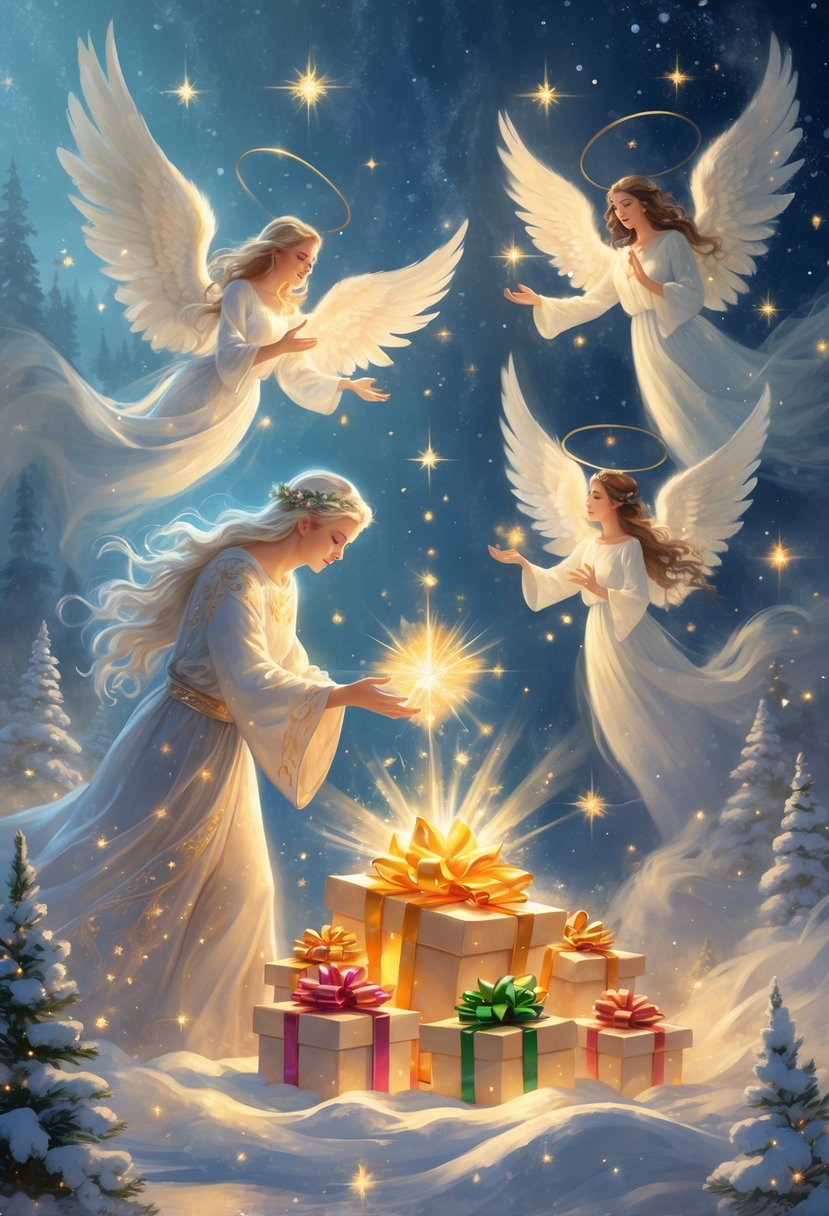
Christmas gift-giving goes all the way back to the Magi’s offerings to baby Jesus. This tradition carries the spirit of divine generosity and transformation.
Giving connects you to deeper meanings—charity, kindness, and the selfless spirit St. Nicholas embodied.
Gifts of the Magi and Their Symbolism
The three wise men offered gold, frankincense, and myrrh to honor Christ. Each gift meant far more than its material value.
Gold pointed to Jesus’s royalty and kingship. It acknowledged his authority and eternal reign.
Frankincense stood for his priesthood and divinity. Used in worship, it recognized Jesus as the bridge between humanity and God.
Myrrh hinted at sacrifice and mortality. This burial spice foreshadowed his death and resurrection for humanity.
When you give gifts at Christmas, you’re joining in this ancient act of honor and recognition. Your presents become offerings that celebrate Christ’s birth and the worth of the people you love.
The Magi’s journey proves that generosity involves sacrifice. They traveled far and gave their best without expecting anything back.
Santa Claus and the Spirit of Giving
St. Nicholas of Myra inspired the Santa Claus we know today through his quiet acts of charity. This 4th-century bishop secretly gave gold to struggling families, laying the foundation for Christmas giving.
The legend tells of Nicholas slipping gold coins down a chimney to help three sisters. His kindness kept a family from poverty and gave hope.
Santa Claus captures the spirit of selfless giving. His jolly attitude and generosity reflect the joy that comes from blessing others, even when no one notices.
Key Santa Claus Values:
- Anonymous giving
- Joy in blessing others
- Special care for children
- Generosity without expecting reward
Your Christmas gifts can echo St. Nicholas’s example. Focus on what the recipient needs, not on impressing anyone. Giving anonymously or helping families who can’t afford presents brings the true spirit of the season to life.
Acts of Kindness, Charity, and Reflection
Gift-giving at Christmas isn’t just about stuff. Spiritual gifts can change hearts and communities.
Charitable giving lets you join in God’s provision for others. Churches and organizations often organize gift drives and donations to help families in need.
Forgiveness is a powerful gift you can offer—sometimes the hardest, but often the most freeing. Christmas is a good time to let go of old hurts.
Prayer for others is a spiritual gift that costs nothing but means everything. Your intercession can bless someone in ways you’ll never fully know.
Time and attention given to lonely or elderly people mirrors Christ’s compassion for the forgotten. Even small gestures matter.
Acts of service—like volunteering at shelters or helping a neighbor—bring the Christmas spirit to life. It’s about putting someone else’s needs ahead of your own comfort.
These non-material gifts often leave a deeper mark than anything you can buy. They ask for real sacrifice and genuine love.
Traditional Plants: Mistletoe, Holly, and Ivy
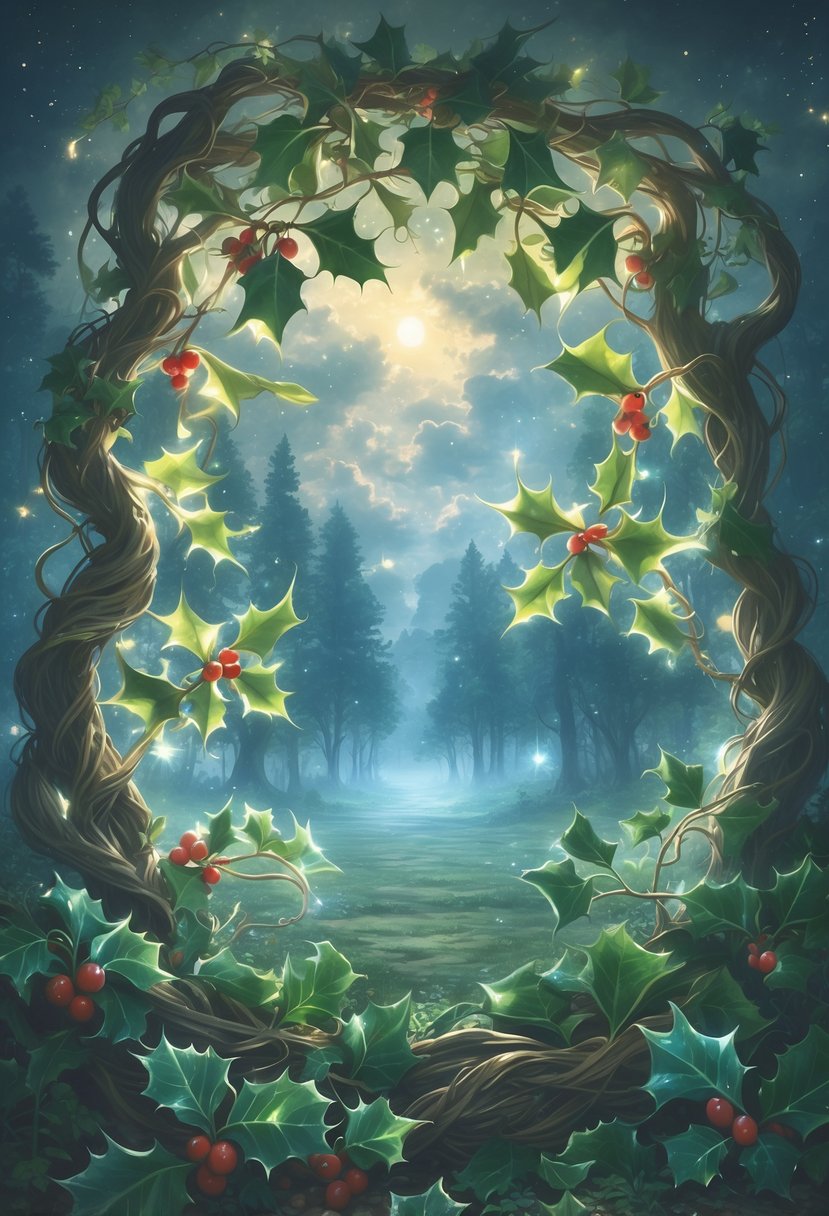
These three evergreens carry spiritual meanings rooted in ancient traditions. Mistletoe stands for love and fertility, holly for protection and enlightenment, and ivy for inner strength.
Mistletoe: Love, Peace, and Fertility
Mistletoe packs a punch as a symbol of love, peace, and fertility. Ancient Druids saw this plant as sacred, especially since it grew on oaks and was thought to have magical properties.
Its reputation for fertility comes from thriving in winter, when most plants fade. That resilience made it a sign of life and renewal. Celtic cultures believed mistletoe could bridge the earthly and spiritual worlds.
When your family kisses under the mistletoe, you’re tapping into old beliefs about love and unity. It’s not just about romance—it’s about forgiveness and healing relationships. Refusing to kiss under mistletoe was once considered bad luck.
The white berries stand for purity and divine blessing. People admired mistletoe’s evergreen nature as a promise of eternal life and spiritual protection for the home.
Holly: Protection and Spiritual Enlightenment
Holly brings powerful symbolism—protection and spiritual enlightenment. Its sharp leaves recall Christ’s crown of thorns, and the red berries symbolize his sacrifice.
The meaning goes deeper than Christian tradition. Ancient people believed holly could protect homes from lightning and bring good luck. Celtic stories spoke of the Holly King ruling winter until the solstice.
Decorating with holly sets a spiritual boundary against negativity. The evergreen leaves symbolize eternal life and the victory of light over darkness. That’s especially meaningful when winter feels longest.
Key Holly Symbolism:
- Protection: Guards against evil spirits
- Enlightenment: Represents divine wisdom
- Sacrifice: Honors Christ’s suffering
- Renewal: Promises spiritual rebirth)
Ivy: Inner Strength and Resilience
Ivy stands for inner strength, resilience, and unwavering faith in many spiritual traditions. What exasperates gardeners about English ivy—its stubbornness and ability to bounce back after being cut—is exactly why ancient religions revered it.
The vine clings to life and survives tough conditions. That makes it a fitting symbol for anyone on a spiritual journey.
Ancient cultures saw ivy as a sign of life force and admired how it stayed green even in the harshest times. They respected its ability to endure.
In the Christmas carol “The Holly and the Ivy,” ivy stands in for Mary, the mother of Jesus. It’s a nod to feminine strength and maternal love.
This connection highlights ivy’s role in family reunion and the invisible ties that hold loved ones together, no matter what.
When you decorate with ivy at Christmas, maybe it’s a reminder to stay persistent in faith. Ivy teaches us that real strength comes from being flexible and adapting, but still holding onto your core values.
Symbols of Light: Candles and the Inner Light
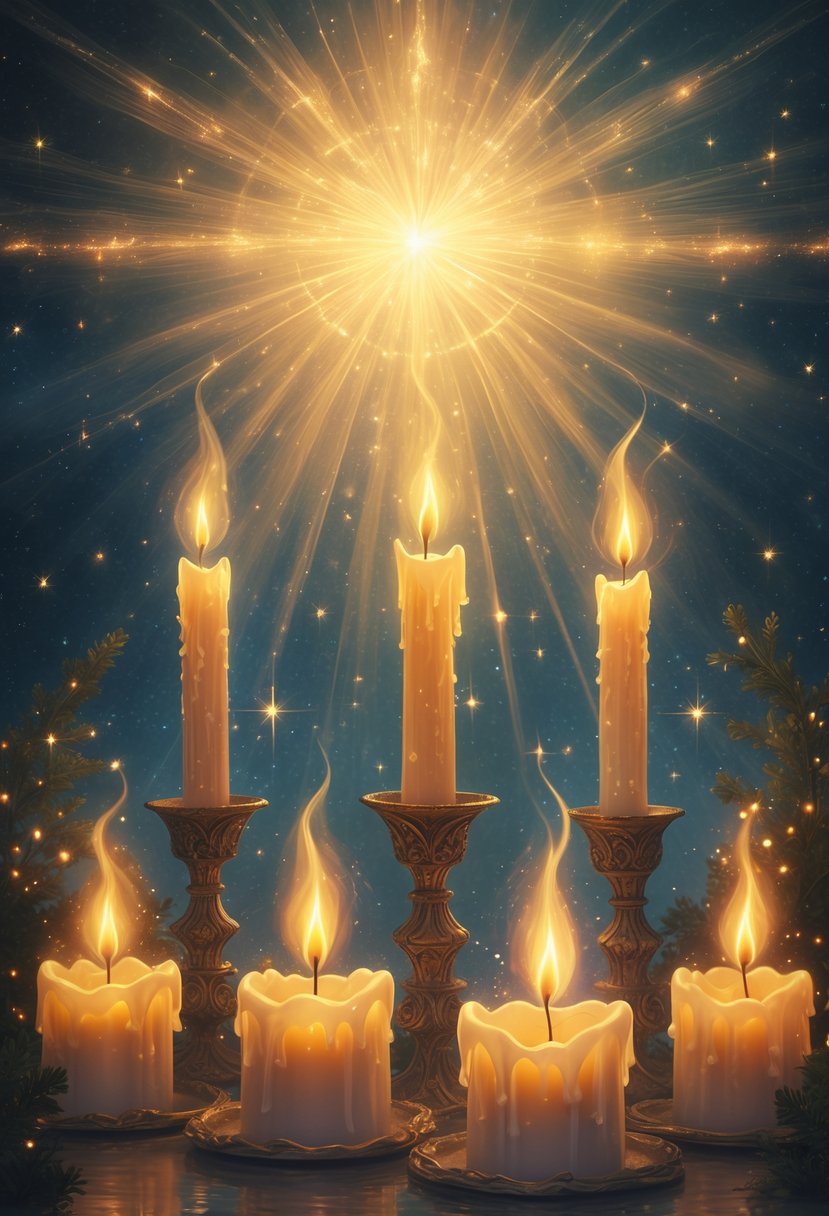
Candles during Christmas connect you to divine light and spiritual awakening. They turn ordinary spaces into something sacred, encouraging prayer and reflection.
These little flames symbolize the inner peace that comes from spiritual practice. There’s just something about their gentle glow.
Candles as Symbols of Faith and Illumination
Candles have always meant a lot as symbols of light in darkness. At Christmas, they represent Christ as the light of the world and your own spiritual awakening.
The flickering flame draws you in, connecting you to something bigger. It acts as a bridge between the physical and spiritual worlds, carrying your hopes and prayers upward.
Christmas candles bring hope, especially in the dark winter months. They remind you that spiritual enlightenment can break through even the darkest times.
Different candle colors add their own meanings:
- White candles: Purity and divine connection
- Red candles: Love and passion for faith
- Gold candles: Divine glory and celebration
Lighting a Christmas candle isn’t just a tradition—it’s almost like a prayer in itself. The simple act focuses your mind on spiritual growth and connection.
Reflection, Prayer, and Inner Peace
Candlelight sets the perfect mood for reflection and prayer. That soft, steady glow can quiet your mind and invite you to look inward.
Lighting candles during Christmas prayer turns ordinary moments into something sacred. The flame helps you focus, making meditation and reflection feel deeper.
Candles help you find inner peace by:
- Creating a calm atmosphere
- Cutting down on distractions
- Representing your inner light
- Encouraging you to be mindful and present
The steady flame mirrors your own inner light—the divine spark that lives in everyone. Watching a candle burn can remind you of your spiritual nature and your potential to grow.
Lighting candles at Christmas can become a ritual of gratitude and remembrance. It’s a way to honor both divine light and your own path toward spiritual transformation.
Christmas Celebrations, Traditions, and Their Spiritual Legacy
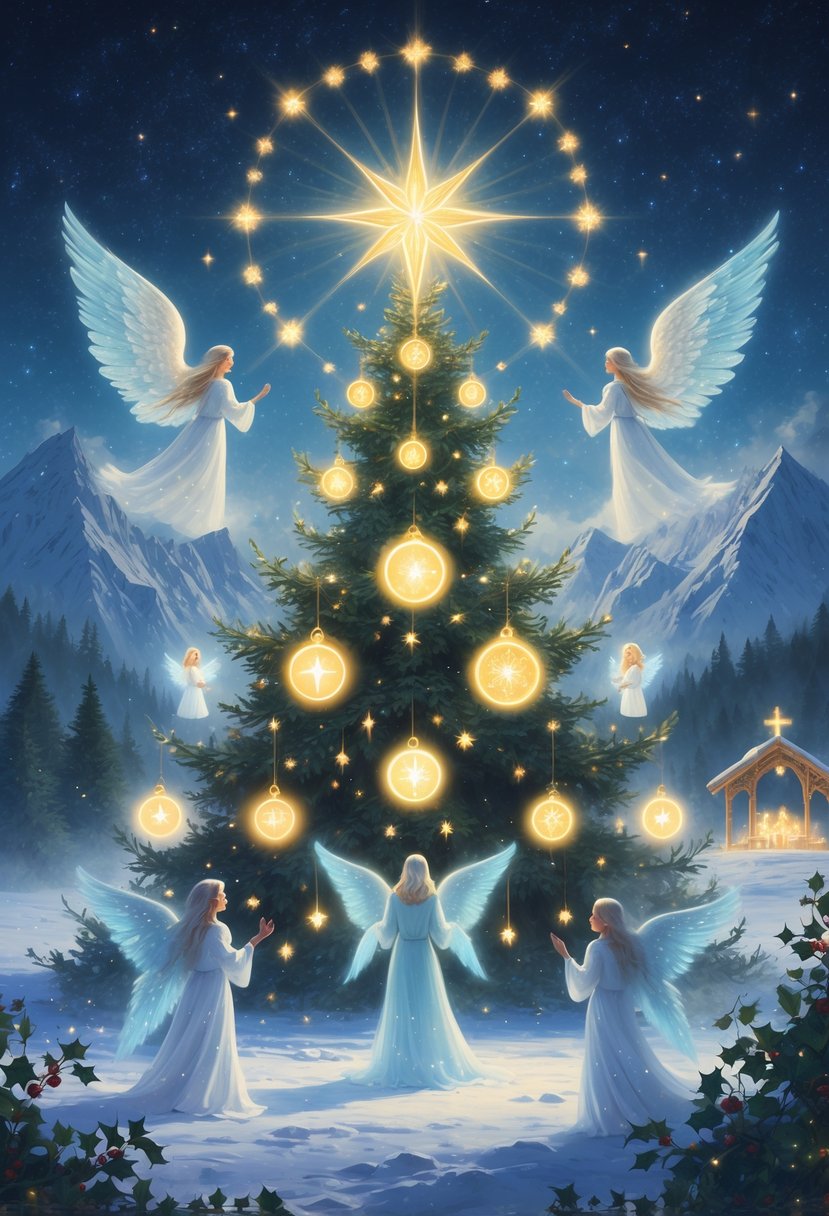
Christmas traditions open doors to spiritual transformation. The twelve days of reflection, music, and family connection all help strengthen your spiritual foundation.
The Twelve Days of Christmas and Spiritual Growth
The twelve days of Christmas give you a built-in chance to deepen your spiritual practice. This sacred stretch runs from December 25th through Epiphany on January 6th.
Each day is a fresh opportunity for reflection and growth. You can use this time to look at different parts of your faith journey.
The tradition nudges you away from the holiday rush. It invites you to focus on spiritual meanings that can change your understanding of love and hope.
A lot of people notice their spiritual growth picking up during these twelve days. The longer celebration means more time for real contemplation.
Some folks dedicate each day to specific spiritual practices. Prayer, meditation, and acts of service can all become daily rituals that bring you closer to the divine.
Christmas Carols and Expressions of Joy
Christmas carols are more than just songs—they’re a way to express spiritual joy and devotion. These tunes carry deep meanings that tie you to centuries of faith.
When you sing carols, it’s like praying through music. Each song tells stories of hope, redemption, and divine love that echo your own spiritual journey.
Old favorites like “Silent Night” and “O Holy Night” create moments of real reverence. They help you feel the spiritual heart of Christmas through melody and words.
Singing carols with others strengthens bonds in the community. It’s group worship that lifts everyone’s spirits and faith.
Caroling out in the world spreads Christmas spirit beyond your close circle. You get to be a messenger of joy, bringing a little spiritual light to neighbors and strangers alike.
Family, Heritage, and Holiday Cheer
Family reunions during Christmas create sacred spaces for passing down spiritual traditions. You strengthen your heritage through shared stories and celebrations that connect generations.
Holiday cheer just sort of bubbles up when families gather and focus on spiritual values. These moments offer a chance to heal relationships or just say thanks for each other.
Your family traditions become vessels for spiritual transmission. Kids pick up faith through actual experience, not just words, when they join in meaningful celebrations.
The warmth of family gatherings feels like divine love in human form. You find the Christmas spirit in forgiveness, acceptance, and that stubborn, unconditional care families somehow manage.
Heritage sticks around when you keep spiritual practices alive across generations. Each family invents its own sacred customs, blending tradition with personal faith in a way that feels honest and real.
Follow us on Social Media!
I’m Nina, and I’m very passionate about spirituality. Exploring the depths of the soul and connecting with the divine has always been my source of inspiration. Join me on a journey of self-discovery and inner peace through my writing.

